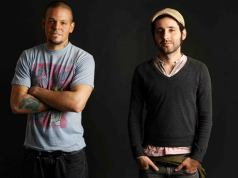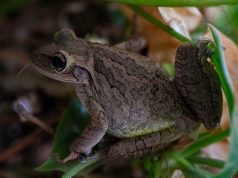

Leading art critic Holland Cotter (The New York Times, 14 November 2025) reviews “Wifredo Lam: When I Don’t Sleep, I Dream,” now on view at the Museum of Modern Art in New York: “The great Cuban modernist, whose politics and Afro-Asian roots shaped his paintings and inspired generations of artists, gets a revelatory survey at MoMA.” [Also see our previous posts When I don’t sleep I dream (12 April 2025) and Wifredo Lam the artist who bridged the Caribbean and Europe… (9 November 2025).]
Art history, which likes categories and keeping things neat, has never known what to do with certain artists, Wifredo Lam (1902-1982) being one. Surrealist? Cubist? Latin American? Afro-Asian? Insider? Outlier? Yes. No. Sort of. Maybe.
So how about we go with Unclassifiably Fabulous Visual Poet? Even a speed-walk through the Museum of Modern Art’s blazingly hallucinatory retrospective, “Wifredo Lam: When I Don’t Sleep, I Dream,” will confirm that, whatever else Lam is, he’s definitely that.
And like many artists, he was his own most eloquent explicator. In an interview he said, “I have been considered a painter of the School of Paris, a Surrealist painter, but never as a representative of the painting that I really do and in which I believe I reflect, to a large extent, the poetry of the Africans who came to Cuba, poetry that still hides much pain in its songs.”
Organized by MoMA’s new director, Christophe Cherix, and Beverly Adams, curator of Latin American Art, and others, the show is the first in the United States to document the full arc of Lam’s career. And it begins, usefully, early, mapping the indirect path that brought Lam to be the artist-poet of his self-description.
He was born in Cuba in 1902, in a sugar-cane-harvesting region, to an immigrant Chinese father and a mother of West African and colonial Spanish descent. Most accounts of his life add a third parental figure, Ma’ Antonica Wilson, a priestess of the Afro-Cuban religion of Santeria, who served as his spiritual godmother.
His parents noted his drawing skills when he was young and sent him to art school in Havana. In 1923, he received a government scholarship earmarked for young persons “of color” and traveled to Spain for further study. For some years there he seems to have stuck with academic fare — still life, landscape — and a realist style, with at least one arresting exception in the form of a Fauve-ish painting of an ambiguously gendered dark-skinned figure wrapped in a florid Chinese robe. A self-portrait?
In 1930 he married and had a child, supporting his new family, precariously, with portrait commissions. Disaster hit. Both his wife and 1-year-old son died of tuberculosis. Grief, it seems, broke Lam down, but also opened him up. He went deeper into art, updating himself on new developments in Paris and the rest of Europe. And he got politically active, joining the Republican army at the start of the Spanish Civil War, a grueling commitment that, in 1937, produced his first major painting.
Titled “La Guerra Civil (The Spanish Civil War),” and done on the cheap, mostly in blue and black gouache on a big sheet of commercial packaging paper, it’s a scene of Fascist troops slaughtering Spanish citizens. The painting style — a chaos of swipes and blotches in a dimensionless space — is half-abstract, but the bad-dream emotion conveyed, of a world in a state of emergency, is specific and strong, a dynamic Lam will recreate in future work.
In 1938, exhausted, he left Spain for Paris, and there a new story starts. On arrival he is embraced by Picasso and the poets and artists of the Surrealist wave. In quick order, he sets up a small studio, lands a gallery, and scores the sale of brand-new work — a Cubist pieta of a picture called “Mother and Child” (it’s in the show) — to MoMA.
But World War II has now started. German troops are in Paris and the art world is streaming out, heading south to Marseilles and from there across the Atlantic to safety. Camped-out life in Marseilles must have been quite a scene, a big, scared party. Artists and writers passed some of this tense time playing the Surrealist game called “Exquisite Corpse,” in which, collectively, they made composite figurative drawings and collages, with each player contributing a part of the image.
Lam participated in the game, and the fantastical, often grotesque imagery that resulted seems to have established a stylistic touchstone for his painting to come. And the sea voyage itself clarified an existing content that was waiting to be revealed.
On the ship’s first stop, in Martinique, Lam met the Black poet and politician Aimé Césaire, shaper of the Negritude movement. They shared an instant rapport and would become collaborators. And partly because of this bonding, when Lam ended his trip in Cuba, landing there for the first time in 18 years, he was ready, in a way he had not consciously been before, to focus his attention on the Afro-Atlantic culture that was his heritage. [. . .]
For full article and photos of the exhibition, see https://www.nytimes.com/2025/11/13/arts/design/wifredo-lam-retrospective-moma.html
Also see our previous posts https://repeatingislands.com/2025/04/12/exhibition-wifredo-lam-when-i-dont-sleep-i-dream/ (April 12, 2025) and https://repeatingislands.com/2025/11/09/wifredo-lam-the-artist-who-bridged-the-caribbean-and-europe-finally-gets-major-retrospective-at-moma/ (November 9, 2025).
[Photo above by Guarionex Rodriguez for The New York Times (Succession Wifredo Lam, Adagp, Paris/ARS, NY): Wifredo Lam, “Grande Composition,” 1949. Oil and charcoal on paper mounted on canvas, it has been out of sight for 60 years.]
Leading art critic Holland Cotter (The New York Times, 14 November 2025) reviews “Wifredo Lam: When I Don’t Sleep, I Dream,” now on view at the Museum of Modern Art in New York: “The great Cuban modernist, whose politics and Afro-Asian roots shaped his paintings and inspired generations of artists, gets a revelatory survey at






